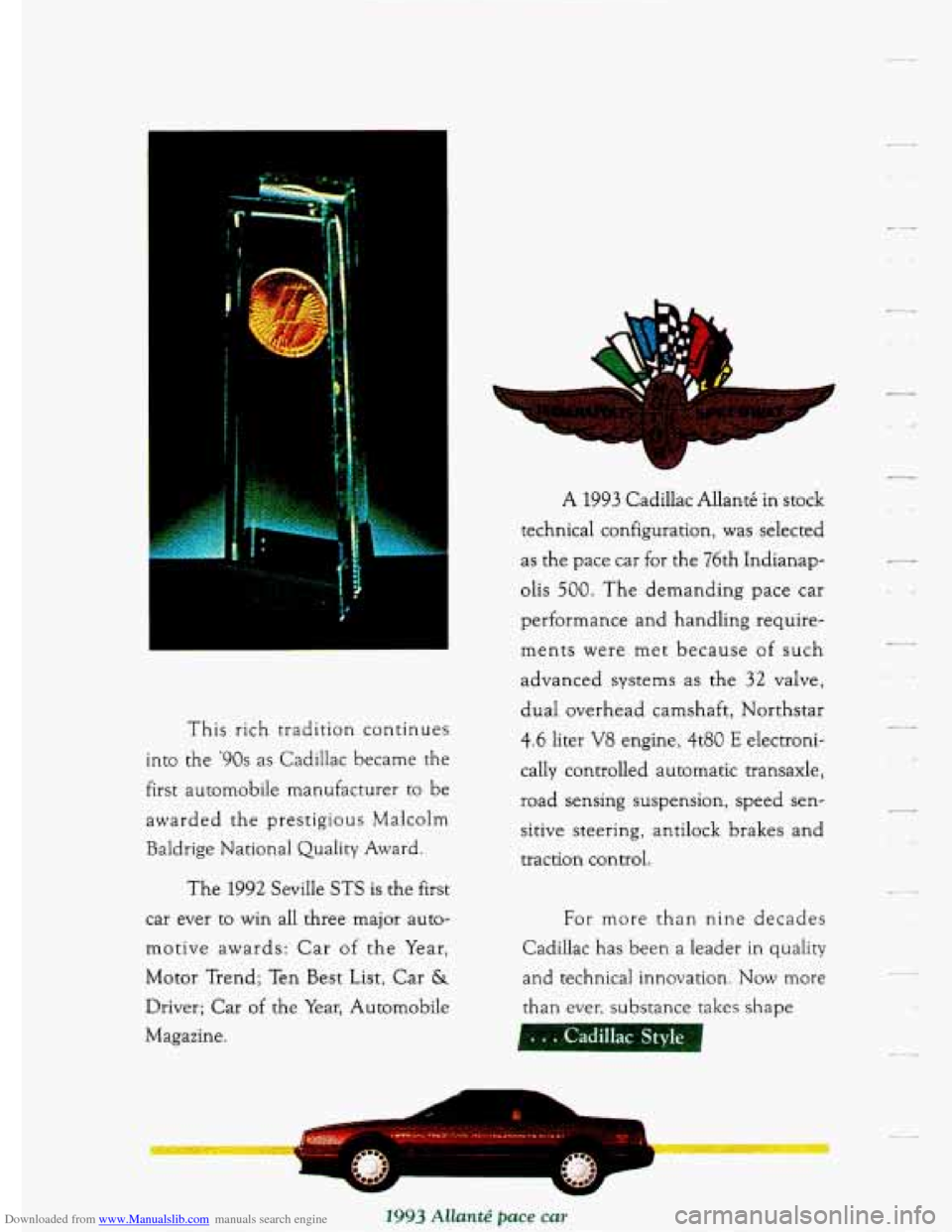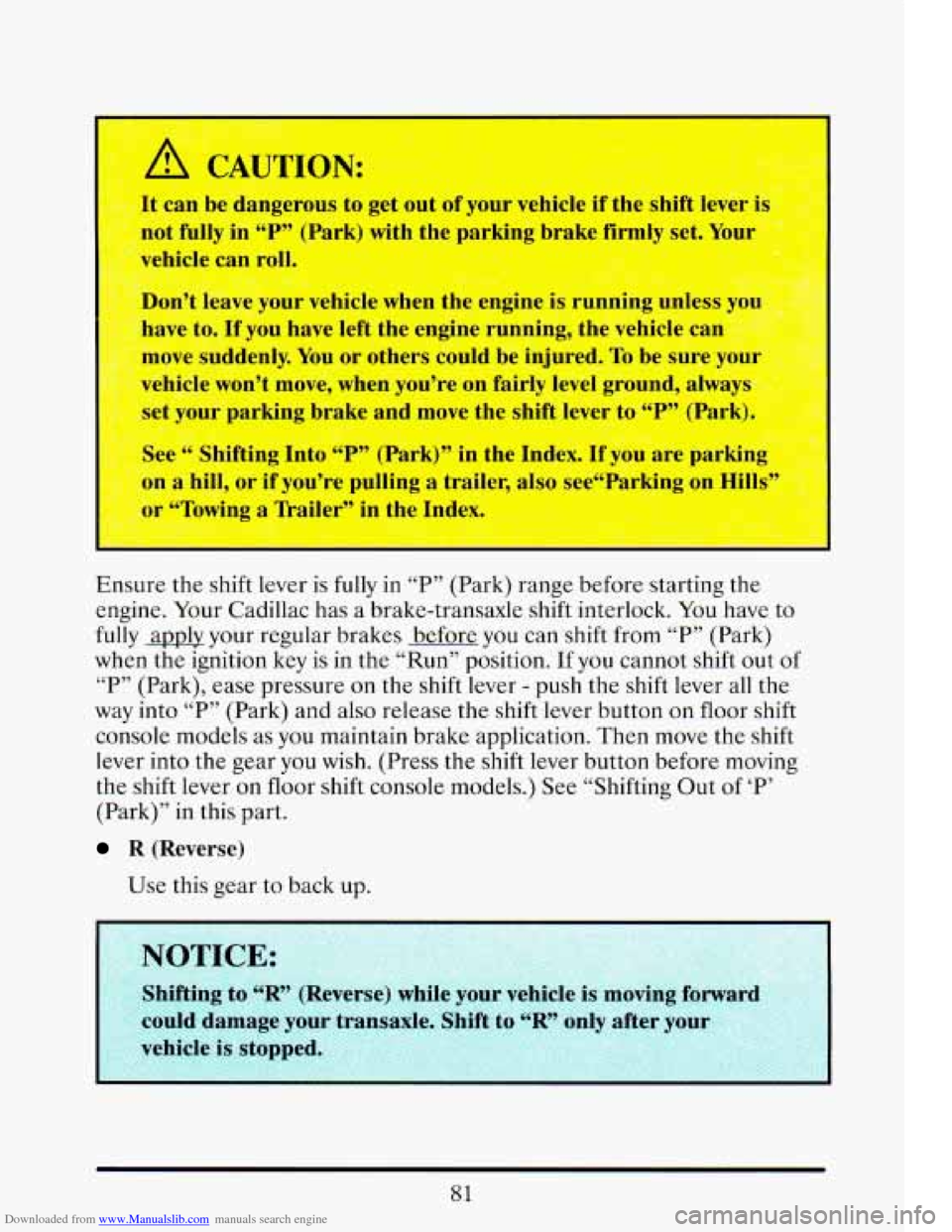Page 10 of 398

Downloaded from www.Manualslib.com manuals search engine 'T - I' 1 i
1
A 1993 Cadillac AllantC in stock
technical configuration, was selected
as the pace car for the
76th Indianap-
olis
500. The demanding pace car
performance and handling require-
ments were met because
of such
advanced systems as the
32 valve,
dual overhead camshaft, Northstar
4.6 liter V8 engine, 4t80 E electroni-
cally controlled automatic transaxle,
road sensing suspension, speed sen-
sitive steering, antilock brakes and
traction control.
This
rich tradition continues
into the
'90s as Cadillac became the
first automobile manufacturer to be
awarded the prestigious Malcolm
Baldrige National Quality Award.
The
1992 Seville STS is the first
car ever to
win all three major auto-
motive awards: Car of the Year,
Motor Trend; Ten Best List, Car
&a
Driver; Car of the Year, Automobile
Magazine.
For more than nine decades
Cadillac has been a leader
in quality
and technical innovation. Now more
than ever, substance takes shape
. . . Cadillac Style j
Page 19 of 398
Downloaded from www.Manualslib.com manuals search engine These symbols are used on warning and indicator lights:
I- I
I
ENGINE COOLANT
TEMPERATURE I
/u/L
BATTERY
CHARGING SYSTEM
u
BRAKE
ENGINE
OIL PRESSURE ENGINE OIL TEMPERATURE
Here are some other
symbols you may see:
A
TRUNK HATCHBACK
RELEASE
U
RADIO SELECTOR
t
l=I
I LIGHTER RADIO VOLUME
1
I HORN 1
RADIATOR
COOLANT
ANTILOCK BRAKE
AIR
CONDITIONING
I
-
SPEAKER
5
Page 76 of 398
Downloaded from www.Manualslib.com manuals search engine -
FEATURES AND CONTROLS
Here you can learn about the many standard and optional features on
your Cadillac, and information on starting, shifting and braking. Also
explained are the instrument panel and the warning systems that tell you
if everything is working properly -- and what to do if you have a problem.
KEYS
I
-. . A CAUTION: I .- .,
:&!;Leaving young children in a vehicle with the ignition key is
‘$$dangerous for many reasons. A child or others could be badly +’A
uE ’
a. mjured or even killed. :a$. :.,gGbkG
They could operate power windows or other controls or even mrlki
the vehicle move.
If they turned the ignition to “ON” and move,
the shift lever out
of “P” (Park), that would release the parking
brake.
Don’t leave the keys in a vehicle with voung children. +-- !
g&:*?:wsac; ---’ :,: -3.5 -.
r, +n I. . A- ;
-
62
Page 95 of 398

Downloaded from www.Manualslib.com manuals search engine vel le tan roll, $2-2.~
Don’t I enicle when the engine is runnmg unles
have
to. If you have left the engine running, the vehicle ca
move suddenly.
You or others could be injured. To be sure
vehicle won’t move, when you’re on
fairly level ground, alw
set your parking brake and move the shift lever to
“P” (Par
See “ snifting Into “P” (Park)” in the Index. 11 you are par
L a hill, or if you’re pulling a trailer, also see“Parking o
or “Towing a Trailer” in the Index.
-*- aq .: : - - . .. .h i-” .. .i T
..
Ensure the shift lever is fully in “P” (Park) range before starting the
engine. Your Cadillac has a brake-transaxle shift interlock. You have to
fully apply your regular brakes before
you can shift from “P” (Park)
when the ignition key is in the “Run” position.
If you cannot shift out of
“P” (Park), ease pressure on the shift lever - push the shift lever all the
way into “P” (Park) and also release the shift lever button on floor shift
console models as you maintain brake application. Then move the shift
lever into the gear you wish. (Press the shift lever button before moving
the shift lever
on floor shift console models.) See “Shifting Out of ‘P’
(Park)” in this part.
R (Reverse)
Use this gear to back up.
81
Page 96 of 398

Downloaded from www.Manualslib.com manuals search engine To rock your vehicle back and forth to get out of snow, ice or sand
without damaging your transaxle, see “If You’re Stuck in Sand, Mud, Ice
or
Snow” in the Index.
N (Neutral)
In this position, your engine doesn’t connect with the wheels. To
restart when you’re already moving, use “N” (Neutral) only. Also, use
“N” when your vehicle is being towed.
A CAUTION:
Shifting out of “P” (Park) or “N” (Neutral) while your engine is
“racing” (running at high speed) is dangerous. Unless your foot
is firmly
on the brake pedal, your vehicle could move very
rapidly. You could lose control and hit people or objects. Don’t
shift out of
“P” (Park) or “N” (Neutral) while your engine is
racing.
Damage to your transaxle caused by shifting out of
“P” (Park
L
0 @ Automatic Overdrive
This position is
for normal driving. If you need more power for
passing, and you’re:
Going less than about
35 mph (56 km/h), push your accelerator
pedal about halfway down.
Going about
35 mph (56 km/h) or more, push the accelerator all
the
way down.
You’ll shift down to the next gear and have more power.
82
Page 97 of 398
Downloaded from www.Manualslib.com manuals search engine L NOTIW:
3 (Third Gear)
This is like
@ , but you never go into Overdrive.
Here are some times you might choose
“ 3 ” instead of @:
- When driving on hilly, winding roads
- When towing a trailer, so there is less shifting between gears
- When going down a steep hill
2 (Second Gear)
This position gives you more power but lower fuel economy. You can
use
“2” on hills. It can help control your speed as you go down steep
mountain roads, but then you would also want to use your brakes
off
and on.
nlh
83
Page 98 of 398
Downloaded from www.Manualslib.com manuals search engine 1 (First Gear)
This position gives you even more power (but lower fuel economy)
than
“2.” You can use it on very steep hills, or in deep snow or mud. If
the selector lever is put in “1,” the transaxle won’t shift into first gear
until the vehicle is going slowly enough.
PARKIN% BRAKE
I
84
Page 99 of 398

Downloaded from www.Manualslib.com manuals search engine To set the parking brake:
Hold the regular brake pedal down with your right foot. Push down the
parking brake pedal with your left foot. If the ignition
is on, the brake
system warnin? light
will come on.
I-
I
When you move out
of “P” (Park) or “N”
(Neutral), if your
engine
is running,
your parking brake should go off.
If it
doesn’t, you have a
parking brake
problem and should have it fixed.
In the
meantime,
you can
still release your
parking brake. Just
pull on the manual
release lever, as
shown.
I
3me-q 5::- &*ZL !My& se-4
A CAUTION: . -- .
If your hand or arm is in the way of thi’pedal, you could be -,::+ -+..:
hurt. The pedal springs back quickly. Keep your hand and arm !+. ,--,:“:
away when you use 1 ! manual release lever. :,F
.L- ..
-.7 7 .--.. , - ., .I .. - .>, _. .- : - .?f I - - .. - --. . ’-: .:. ..:= . ’. + .? .. .
NOTICE
Driving with the parking lake on can cause ~UL- rear bra,
overheat.
You mav have to replace them- and vou could also
,.*age ~ ~. .: . ~ i nther pal vnur vfihicle.
L .~-:’? . - I . - . i i .. ~
85